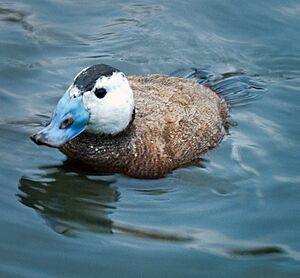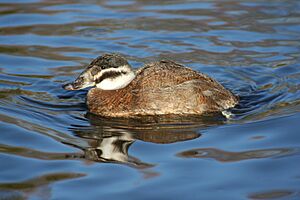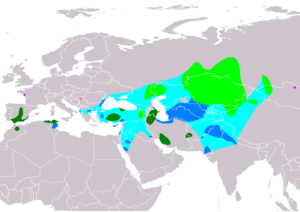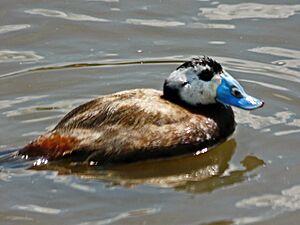White-headed duck facts for kids
Quick facts for kids White-headed duck |
|
|---|---|
 |
|
| Male in summer | |
 |
|
| Female | |
| Conservation status | |
| Scientific classification | |
| Genus: |
Oxyura
|
| Species: |
leucocephala
|
 |
|
| Oxyura leucocephala range
Breeding Resident Non-breeding Passage Vagrant (seasonality uncertain) Probably extinct |
|
The white-headed duck (Oxyura leucocephala) is a small diving duck. It grows to about 45 centimeters (18 inches) long. The male duck has a white head with a black cap and a bright blue bill. Its body is reddish-grey. The female looks a bit different, with a darker bill and duller colors.
These ducks live near lakes with open water and lots of plants around the edges. They dive underwater to find food. They mostly eat water plants, but also some small animals. If they feel in danger, they prefer to swim away rather than fly. You can find these ducks in places like Spain, North Africa, and parts of Asia. Sadly, their numbers are going down. This is mainly because their homes are being destroyed or polluted. Because of this, the International Union for Conservation of Nature says the white-headed duck is an "endangered" bird.
Contents
What's in a Name?
The white-headed duck was first named Anas leucocephala in 1769. Its scientific name today is Oxyura leucocephala. The name Oxyura comes from two Greek words: oxus, meaning "sharp," and oura, meaning "tail." This describes their stiff, pointed tails. The second part, leucocephala, also comes from Greek. Leukos means "white," and kephalos means "head." So, its scientific name means "sharp-tailed white-head." This is just like its common name, the white-headed duck!
These ducks can sometimes breed with other ducks in their family, like the ruddy duck. Their mixed offspring can also have babies. This can be a problem for the white-headed duck, which we will learn about later.
How to Spot a White-headed Duck
Adult male white-headed ducks have a grey and reddish body. They have a bright blue bill and a mostly white head with a black cap and neck. Adult females have a grey-brown body. Their face is white, but they have a darker bill, cap, and a stripe on their cheek.
These ducks are usually between 43 and 48 centimeters (17-19 inches) long. They weigh about 580 to 750 grams (1.3-1.7 pounds).
Where They Live
White-headed ducks breed in Spain and North Africa. A larger group of them lives in western and central Asia. They like to make their homes in big areas of open water. This includes lakes, ponds, and even man-made water bodies. They need lots of water plants around for shelter and places to build their nests.
Sometimes, these ducks are seen far north of where they usually live. However, it can be hard to tell if these ducks flew there on their own or if they escaped from bird collections.
What They Eat and How They Live
These birds are excellent divers and swimmers. They spend a lot of time underwater looking for food. White-headed ducks are omnivorous, meaning they eat both plants and animals. Most of their diet is made up of water plants. They are not very keen on flying. If they feel threatened, they would rather swim away and hide in the plants.
Protecting the White-headed Duck
The white-headed duck is an endangered bird. Its population has dropped a lot in the last 10 years. The main reasons for this decline are loss of their habitat and hunting.
Another big problem, especially for the ducks in Spain, is interbreeding. They are breeding with an introduced duck called the ruddy duck (Oxyura jamaicensis). The ruddy duck is not native to these areas. When the two species breed, it can make it harder for the pure white-headed duck population to survive. Because of this, people are trying to remove the ruddy duck from western Europe.
The white-headed duck is part of an agreement called the Agreement on the Conservation of African-Eurasian Migratory Waterbirds (AEWA). This agreement helps protect birds that migrate across Africa and Eurasia. The International Union for Conservation of Nature has officially listed the white-headed duck as "endangered." This means it needs special protection to survive.




